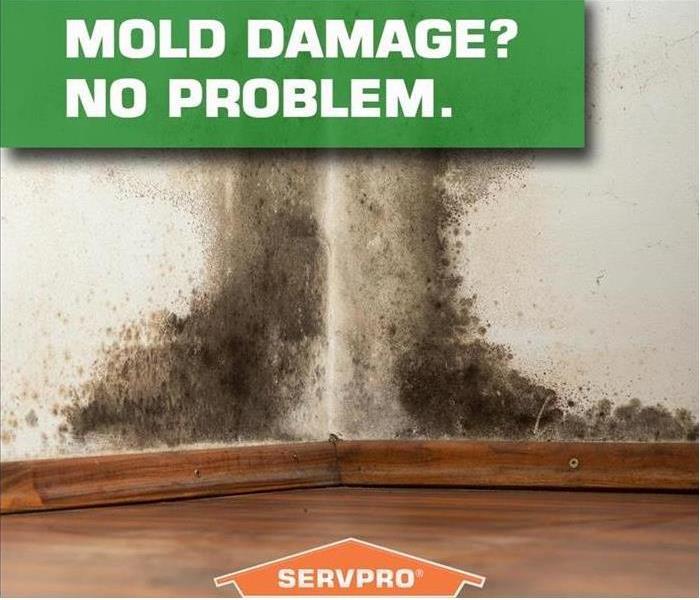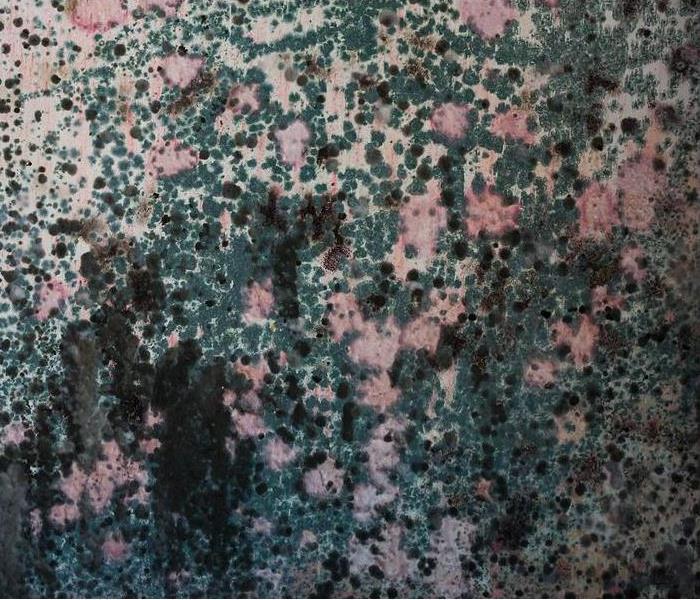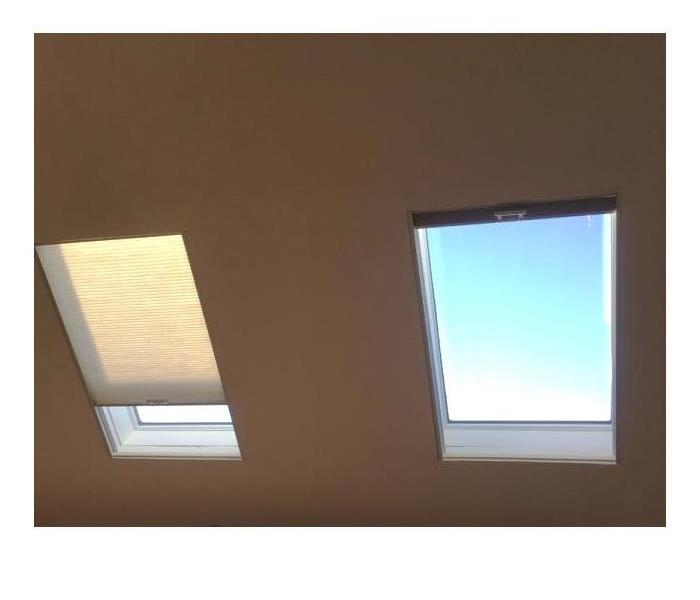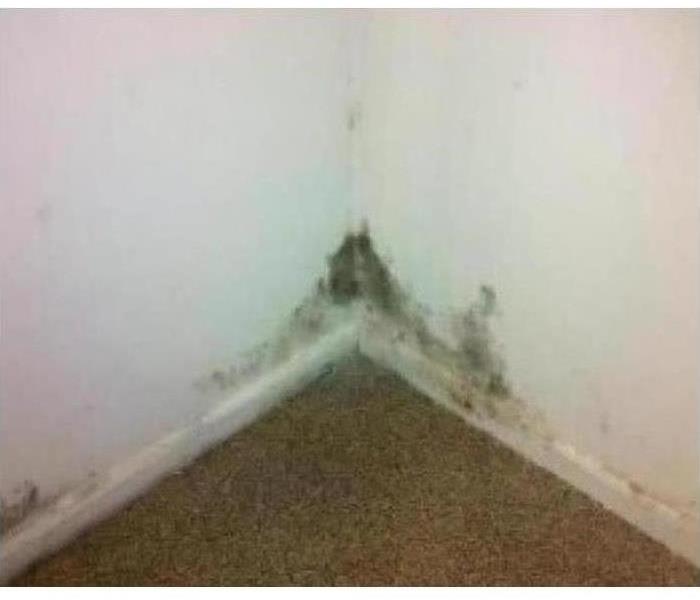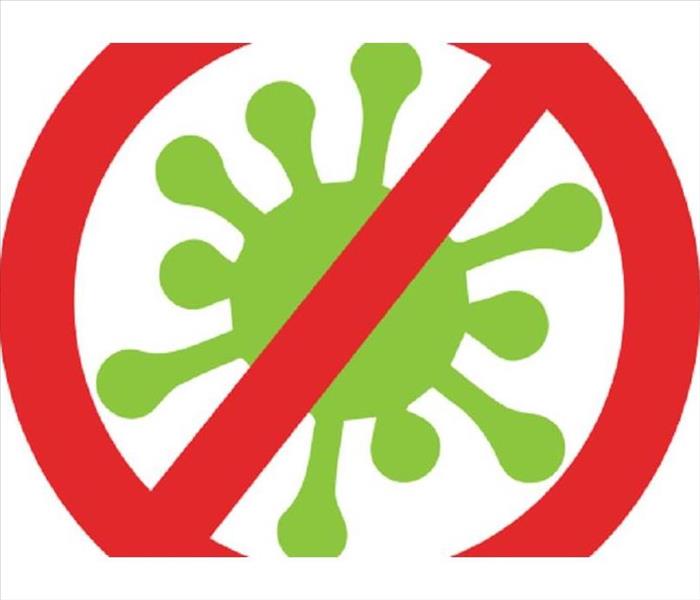Recent Mold Remediation Posts
How Big Of A Health Problem Can Mold Be
8/5/2024 (Permalink)
Mold, a layman term used to identify a variety of fungi, which can easily be classified as unappealing and disliked. Mold can exist both indoors as well as outdoors in the form of variously colored, smelly, and unsightly fuzzy patches. However, the sight and smell of mold are the least of your worries as the effect on your health has been far worse.
How Does Mold Spread Health Problems
While mold exists on surfaces, it does produce a variety of spores, which then spread throughout the air in your property. In fact, if a patch of mold exists on your property, there isn't much that you can do that will prevent it from spreading these spores, which will only allow for the health issues to persist. Certain types of molds are even known to digest the surface that they are growing on. This is why you need to remove the mold itself.
Health Issues Caused By Molds
There are a variety of health issues inflicted on people who are exposed to mold. In fact, mold can affect different people with different health issues. So to show you how big of an issue mold can be on your health, here is a list of health issues caused by exposure to mold.
Respiratory Issues
The spores from mold that float in the air can produce a variety of irritants, mycotoxins, and allergens. Some of them have toxic nature and can greatly affect those who might be sensitive to them. So these toxic elements can then cause irritation within your throat, nose, and even lungs, which can cause you to become asthmatic or develop a chronic lung problem.
Allergies
Mold can also cause you to develop symptoms that overlap with different types of allergies, which can include seasonal allergies and even hay fever. So, symptoms, such as an itchy, blocked, or runny nose, excessive sneezing, and even watery eyes could persist as it affects your upper respiratory tract. People who are already asthmatic could begin to have asthma attacks due to the mold.
Aspergillosis
Aspergillosis is a variation of mold that can cause a variety of different types of health issues in different types of people. The health issues can include issues with lung function, headaches, coughing so severe that it could cause you to cough up blood, respiratory issues, and weight loss.
Other Health-Related Issues
Apart from toxins and irritants, mold also can produce bacteria and microbes. If one is exposed to such productions, then it could trigger their body to have an inflammatory response. It can also cause infections, such as a fungal or bronchial infection. In fact, for some, mold can even cause issues, such as hypersensitivity pneumonitis, bronchitis, and insomnia.
All in all, the growth of any variation of mold can and should be treated like the plague as it is quite a significant threat to your health. This means that all of the necessary precautions should be taken in order to ensure that it does not damage you or your loved one's health.
Mold Remediation and Restoring
9/18/2020 (Permalink)
Any home or business can quickly become infested with mold with the introduction of a water source, like a roof or plumbing leak. Mold can spread throughout a property in as little as 48-72 hours, and can produce allergens and irritants that have the potential to cause other health effects.
If you suspect that your home or business has a mold problem, SERVPRO of Cherry Hill/Haddonfield Restoration Franchise Professionals can inspect and assess your property. If mold is found, they have the training, equipment, and expertise to handle the situation.
SERVPRO of Cherry Hill/Haddonfield Restoration Franchise Professionals
- Provide 24/7 Emergency Service
- Highly Trained Water Restoration Specialists
- Faster to Any Size Disaster
- A Trusted Leader in the Restoration Industry with over 1,650 Franchises
If You See Signs of Mold, Call 856-662-2772
Understanding Mold
Microscopic mold spores exist almost everywhere, outdoors and indoors, making it impossible to remove all mold from a home or business. Some restoration businesses advertise “mold removal” and even guarantee to remove all mold, which is a fallacy. Consider the following mold facts:
- Mold is present almost everywhere, indoors and outdoors.
- Mold spores are microscopic and float along in the air, and may enter your home through windows, doors, or AC/heating systems or even hitch a ride indoors on your clothing or on a pet.
- Mold spores thrive on moisture. Mold spores can quickly grow into colonies when exposed to water.
- Before mold remediation can begin, any sources of water or moisture must be addressed. Otherwise, the mold may return.
- Mold often produces a strong, musty odor and can lead you to possible mold problem areas.
- Even higher-than-normal indoor humidity can support mold growth. Keep indoor humidity below 45 percent.
Common Mold Misconceptions
With sensational news stories and misleading advertising, you can easily understand why so many people are misinformed about indoor mold. Learn the facts about mold and the mold remediation process.
Why Choose a SERVPRO of Cherry Hill/Haddonfield Restoration Franchise Professional?
They’re Faster to Any Size Disaster
SERVPRO of Cherry Hill/Haddonfield Franchise Professionals are dedicated to responding immediately when you contact them. A fast response lessens the damage, limits further damage, and reduces cost.
They’re Highly Trained Mold Remediation Specialists
They specialize in water and mold damage restoration, the cornerstone of our business. SERVPRO of Cherry Hill/Haddonfield Franchise Professionals have the training and expertise to safely handle any mold situation.
- Applied Microbial Remediation Specialist
- Water Damage Restoration Technician
- Applied Structural Drying Technician
They Use Advanced Mold Remediation Techniques and Equipment
SERVPRO of Cherry Hill/Haddonfield Restoration Franchise Professionals use advanced equipment to detect the source of water feeding the mold. Next, they isolate the affected area using a negative air pressure chamber.
Water Forming in Your Central Air Conditioner
9/19/2019 (Permalink)
Water has started to pool around your central air conditioner’s inside unit and you have no idea why.
First, you should turn off your air conditioner because this water could harm the electronic parts of your AC and cause water damage to your home. Then you should contact a professional AC repair person for help.
If you want to understand the cause of this problem before calling a professional, read this article.
We’ll talk about:
- Why water forms in the inside AC unit
- Why there’s water all over the floor
- What needs to be done to fix it
Why water forms in a central air conditioner indoor unit
Part of your air conditioner’s job is to pull humidity from the air. The inside unit’s blower pulls in hot, humid air through the return grille and over the inside unit’s cold evaporator coil to cool the air down.
When that happens, condensation/droplets form on the evaporator coil. It’s just like when water droplets bead up on a glass of ice cold water on a hot summer day in Georgia.
That water on the evaporator coil falls into a sloped drain pan and down a condensate drain line like a slip n’ slide. That drain line (usually a PVC pipe) either exits out the home (usually near the outside unit) or into your plumbing.
OK, so now you have a general idea of how the water forms and the parts involved. If there’s an issue with any of these parts, that’s why the water is forming around the inside unit.
Here are a few common problems that are causing the issue you’re having.
Clogged condensate drain line or rusted condensate drain pan
If the drain line gets clogged by dirt, insects, mold, or anything else, the water has nowhere to go but back into the home. (Some home’s have a secondary drain line but that may also be become clogged.)
Use wet-dry vacuum to suck out the obstruction from the outdoor PVC condensate pipe.
Also the root of the problem may be a dirty evaporator coil. The dirt will mix with the water and fall down into the pan, clogging the drain. Have a professional clean this coil annually as part of an annual AC maintenance visit.
Also, the drain pan may be rusted through and is falling onto the floor and causing damage to your home. So you’ll need to replace that.
Note: Your air conditioner may have a secondary drain pan to catch the water. This pan has a float switch that turns off your air conditioner to prevent water damage.
Installation issues
If you have a newer air conditioner, the problem may be installation related. An improperly designed condensate trap will stop the condensate from draining. So all that water builds up in the drain pan and overflows into your home, causing water damage.
You’ll need a professional to examine the condensate trap to see if it has been designed properly and fix it if necessary.
Frozen evaporator coil
Open the blower door of your inside AC unit. Is the evaporator coil covered in ice? When that frozen evaporator coil melts there may be so much water that it flows over the drain pan and then onto the floor.
There are 2 common causes of a frozen evaporator coil:
- Dirty air filter—A dirty air filter blocks airflow over the evaporator coil, causing the temperature to drop below freezing and ice up. Check the air filter and change it if it’s dirty.
- Low refrigerant— Low refrigerant causes the evaporator coil to become much colder than normal, causing it to freeze up.
To defrost the evaporator coil, turn the air conditioner off. Then turn the blower from “auto” to “on.” The fan should melt the ice slowly enough for the drain pan to handle all the water.
In the meantime, you should call a professional AC repairman to check your air conditioner to make sure it’s is working properly and ensure nothing was damaged.
Just a few of many issues…
There are other causes of water pooling around an inside air conditioning unit, but these are some of the most common.
Mold Removal vs. Mold Remediation
9/20/2018 (Permalink)
Since microscopic mold spores exist naturally almost everywhere, indoor and outdoor, removing all mold from a home or business is impossible. Many restoration business advertise "mold removal" and even guarantee to remove all the mold. This is a fallacy. We understand that mold and mold growth. SERVPRO of Cherry Hill/Haddonfield has the training and expertise to remediate the mold in your home or business.
Understanding Mold
When water intrudes into your property, mold growth can start in as little as 48 hours.
The Mold Remediation Process
Every mold damage scenario is different and requires a unique solution, but the general mold remediation process stays the same.
- Contact SERVPRO of Cherry Hill/Haddonfield
- Inspection and Mold Damage Assessment
- Mold Containment
- Air Filtration
- Removing Mold and Mold-Infested Materials
- Cleaning Content and Belongings
Frequently Asked Questions About Mold
8/2/2018 (Permalink)
Mold removal, also known as mold remediation, can be a complicated and confusing process for many people. You're already stressed that mold was found in your home or business and you just want it out, but the proper way to remove it may not be what you'd expected.
- What Does Mold Look Like?
- Mold has many different appearances from varying textures, colors, and sizes.
- What Causes Mold?
- Mold can be caused by many different things, but in most cases a warm, damp area with poor ventilation and some type of nutrient will cause mold.
- Can I Remove the Mold in My Home Myself?
- You Shouldn't remove mold yourself unless you can throughout the contaminants without any danger to health. Mold is difficult and tricky, and in some cases, you can actually make it worse.
Contact SERVPRO of Cherry Hill/Haddonfield for all of your mold needs!
Why is Your Skylight Leaking?
7/13/2018 (Permalink)
Why is Your Skylight Leaking?
Skylights leak for a variety of reasons. Due to the dangers of working in elevated areas, only an experienced contractor should inspect or repair your skylight. Before you talk to a professional, try to determine when and where the leak occurs. Pay attention to when and where the skylight seems to be leaking. A constant drip should be investigated by a professional as soon as possible. For a seemingly intermittent leak, try to determine what is causing water to infiltrate. Does the leak seem to worsen after a rainfall? Is it better at certain times of the year? Or, is the problem steadily growing worse? The different causes of leaks can lead to very different recommended repairs. Here are some of the most common factors contributing to skylight leaks.
- Roof Issues
- Improper Sealing
- Cracked Skylight
- Indoor Condensation
Mold and Your Health
7/9/2018 (Permalink)
Exposure to damp and moldy environments may cause a variety of health effects, or none at all. Areas that are likely to have mold, such as compost piles, cut grass, and wooded areas.
Molds are part of the natural environment. Outdoors, molds play a part in nature by breaking down dead organic matter such as fallen leaves and dead trees, but indoors, mold growth should be avoided. Molds reproduce by means of tiny spores; the spores are invisible to the naked eye and float through outdoor and indoor air. Mold may begin growing indoors when mold spores land on surfaces that are wet. There are many types of mold, and none of them will grow without water or moisture.
The key to mold control is moisture control. If mold is a problem in your home, you should clean up the mold promptly and ix the water problem.
It is important to dry water-damaged areas and items within 24-48 hours to prevent mold growth.
Molds gradually destroy the things they grow on. You can prevent damage to your home and furnishings, save money, and avoid potential health problems by controlling moisture and eliminating mold growth.
Mold Prevention Tips
6/14/2018 (Permalink)
The most common places for mold growth in your home are basements, bathrooms/showers, attics and craw spaces. You can help prevent your home form becoming an environment for mold growth. Here's how:
- Moisture control is KEY. Keep areas clean and dry. Dry wet or dam areas within 48 hours.
- Watch for condensation and wet spots. Fix the source of moisture problem as soon as possible.
- Maintain low indoor humidity, below 60 percent relative humidity.
- Keep heating, ventilation, and air conditioning drip pans clean, flowing properly, and unobstructed.
- Vent moisture generating appliances, such as dryers, to the outside where possible.
If you are not experienced with home/building repairs you may want to consider a professional mold specialist when making repairs.
If Mold damage, threatens your home or office contact SERVPRO of Cherry Hill/Haddonfield. We are here to help and care for not only your home or office, but for you as an individual.
DIY Mold Removal
6/14/2018 (Permalink)
DIY Mold Removal:
Suit up for safety: Protect yourself from the mold you're removing by wearing rubber gloves, a long sleeve shirt and paints while cleaning. Also, use a mask or respirator to avoid inhaling spores into your lings.
Dehumidify
Inspect Plumbing: All leaky faucets, pipes and other plumbing items need to be repaired. This keeps moisture out of your house and avoids mold from water damage.
Assess Mold On Wood
Disinfect Problem Areas: Once you've remove the mold you can see, disinfect the area with something like a mixture of bleach and water that has 1/4 cup bleach per gallon of water. Apply the mixture to the problem are and let it set for 15 minutes. Rinse off the solution and let it dry.
Keep Your House Dry
However, SERVPRO professionals are near by if you'd rather to leave your home or office mold damage to them, contact SERVPRO of Cherry Hill/Haddonfield. We are here to help and care for not only your home or office, but for you as an individual.
Mold in your Cherry Hill Home
6/13/2018 (Permalink)
SERVPRO understands the stress when you have a water damage in your business or home. That is why we are available 24/7 to help. Our team is fast and quick to any job at any size.
Our certified technicians will mitigate the damage to prevent mold, mildew or bacteria. Using EPA disinfectants, we will make your business or home safe to reenter and occupy. We make sure our team is trained and up to date with all of their credentials.
SERVPRO has been trusted by local business's and insurance companies to assist with their water damage projects. We are there when your family needs help the most. Any type of damage in your home can be a devastating time and can cause a lot of stress in the household. Working with true professionals can definitely help the process and get your home back to normal as quickly as possible.
SERVPRO of Cherry Hill/Haddonfield Satisfied Mold Damage Customers
6/13/2018 (Permalink)
 SERVPRO of Cherry Hill/ Haddonfield Strives for Customer Satisfaction on All Jobs
SERVPRO of Cherry Hill/ Haddonfield Strives for Customer Satisfaction on All Jobs
We strive every day to ensure that our quality of work is up to the highest standards and we are always happy to get positive feedback from our customers.
Here are some recent quotes from real customers:
"The team rendered excellent customer service and I would recommend their service to others." - Kevin F.
"In spite of the mold work the crew was doing on the hot temperatures of my house they always had a smile and were very consistent." - Rochelle
If mold damage threatens your home or office contact SERVPRO of Cherry Hill/Haddonfield. We are here to help and care for not only your home or office, but for you as an individual.
Got Mold? SERVPRO of Cherry Hill/Haddonfield is Here to Help!
6/6/2018 (Permalink)
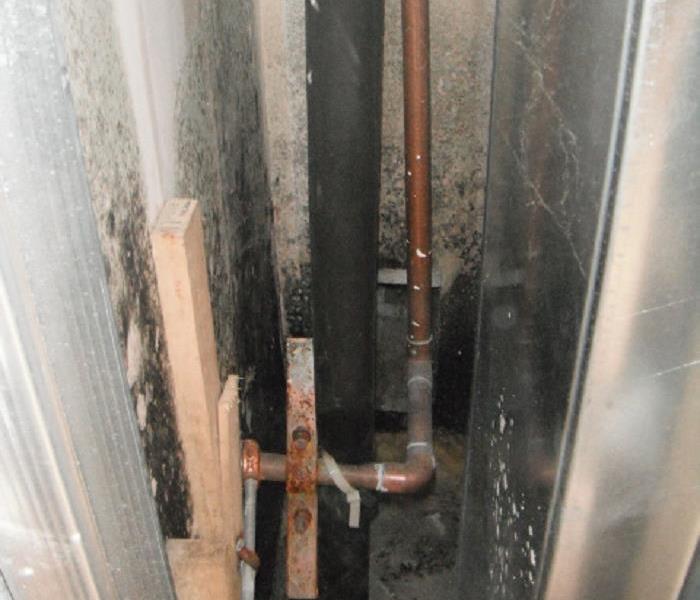 Mold was caused by a leak in the walls.
Mold was caused by a leak in the walls.
Business found mold due to a leak in their walls. SERVPRO of Cherry Hill/Haddonfield was able to help.They restored the business "Like it never even happened."
Water damage in Collingswood NJ, Water damage in Audubon NJ, Why Is Water Leaking From My Central Air Conditioners Inside,
7/31/2017 (Permalink)
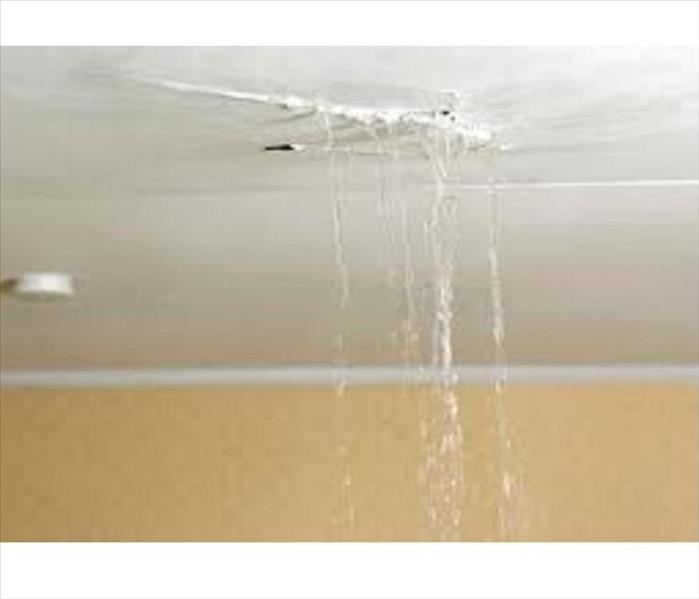 Water damage in Collingswood NJ, Water damage in Audubon NJ, Why Is Water Leaking From My Central Air Conditioners Inside,
Water damage in Collingswood NJ, Water damage in Audubon NJ, Why Is Water Leaking From My Central Air Conditioners Inside,
Water has started to pool around your central air conditioner’s inside unit and you have no idea why.
First, you should turn off your air conditioner because this water could harm the electronic parts of your AC and cause water damage to your home. Then you should contact a professional AC repair person for help.
If you want to understand the cause of this problem before calling a professional, read this article.
We’ll talk about:
- Why water forms in the inside AC unit
- Why there’s water all over the floor
- What needs to be done to fix it
Why water forms in a central air conditioner indoor unit
Part of your air conditioner’s job is to pull humidity from the air. The inside unit’s blower pulls in hot, humid air through the return grille and over the inside unit’s cold evaporator coil (pictured above) to cool the air down.
When that happens, condensation/droplets form on the evaporator coil. It’s just like when water droplets bead up on a glass of ice cold water on a hot summer day in Georgia.
That water on the evaporator coil falls into a sloped drain pan and down a condensate drain line like a slip n’slide. That drain line (usually a PVC pipe) either exits out the home (usually near the outside unit) or into your plumbing.
OK, so now you have a general idea of how the water forms and the parts involved. If there’s an issue with any of these parts, that’s why the water is forming around the inside unit.
Here are a few common problems that are causing the issue you’re having.
Clogged condensate drain line or rusted condensate drain pan
If the drain line gets clogged by dirt, insects, mold, or anything else, the water has nowhere to go but back into the home. (Some home’s have a secondary drain line but that may also be become clogged.)
Use wet-dry vacuum to suck out the obstruction from the outdoor PVC condensate pipe.
Also the root of the problem may be a dirty evaporator coil. The dirt will mix with the water and fall down into the pan, clogging the drain. Have a professional clean this coil annually as part of an annual AC maintenance visit.
Also, the drain pan may be rusted through and is falling onto the floor and causing damage to your home. So you’ll need to replace that.
Note: Your air conditioner may have a secondary drain pan to catch the water. This pan has a float switchthat turns off your air conditioner to prevent water damage.
Installation issues
If you have a newer air conditioner, the problem may be installation related. An improperly designed condensate trap will stop the condensate from draining. So all that water builds up in the drain pan and overflows into your home, causing water damage.
You’ll need a professional to examine the condensate trap to see if it has been designed properly and fix it if necessary.
Frozen evaporator coil
Open the blower door of your inside AC unit. Is the evaporator coil covered in ice? When that frozen evaporator coil melts there may be so much water that it flows over the drain pan and then onto the floor.
There are 2 common causes of a frozen evaporator coil:
- Dirty air filter—A dirty air filter blocks airflow over the evaporator coil, causing the temperature to drop below freezing and ice up. Check the air filter and change it if it’s dirty.
- Low refrigerant— Low refrigerant causes the evaporator coil to become much colder than normal, causing it to freeze up.
To defrost the evaporator coil, turn the air conditioner off. Then turn the blower from “auto” to “on.” The fan should melt the ice slowly enough for the drain pan to handle all the water.
In the meantime, you should call a professional AC repairmanto check your air conditioner to make sure it’s is working properly and ensure nothing was damaged.
Just a few of many issues…
There are other causes of water pooling around an inside air conditioning unit, but these are some of the most common.
Humidity, Water Damage in Mt. Laurel NJ, Condensation, Mold, and Indoor Air Quality, in Mt. Laurel NJ,
7/12/2017 (Permalink)
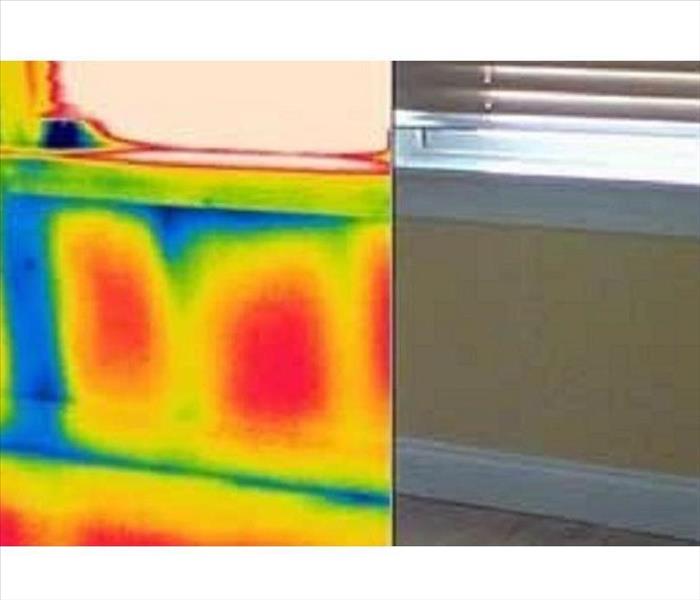 Humidity, Water Damage in Mt. Laurel NJ, Condensation, Mold, and Indoor Air Quality, in Mt. Laurel NJ,
Humidity, Water Damage in Mt. Laurel NJ, Condensation, Mold, and Indoor Air Quality, in Mt. Laurel NJ,
Humidity, Water Damage in Mt. Laurel NJ, Condensation, Mold, and Indoor Air Quality, in Mt. Laurel NJ,
Moisture rides on air currents, and warm air carries more moisture than cool air
To control air flows, make sure the air barrier is continuous
An air barrier helps control airflow both through and within the building enclosure. By controlling airflow, you also control moisture.
If moist indoor air contacts a cold surface — for example, exterior sheathing in cold weather — condensation can result. An air barrier prevents those cold surfaces from being connected with humid indoor air.
Air has a maximum storage capacity for water vapor which depends on temperature. Warm air can store lots of moisture, while cold air can store very little.
As the temperature falls from 90°F down to 20°F, the amount of moisture that can be stored in the air changes by a factor of ten.
Leaky homes didn’t have condensation problems
Older buildings rarely had condensation problems in cold weather because they were so well ventilated — meaning leaky. The relative humidity in an old home would rarely rise above 25%. As we have built tighter houses (and in some cases failed to provide mechanical ventilation), the indoor relative humidity has gone up.
In a heated, tight, unventilated house, the amount of moisture in the air and the amount of condensation that can occur are dramatically different than in an old leaky house. Condensation can occur wherever water vapor can find a cold spot — on roof or wall sheathing, on the inside faces of the windows, and inside the walls.
Let's say it’s 40°F outside and the outdoor relative humidity is 50%. If you allow that outdoor air to enter a building and heat it up to 70°F, the amount of moisture in the air stays exactly the same, but the “tank” gets bigger because the storage capacity of the air increases with the temperature. As a result, the relative humidity initially drops. Then, as moisture is added to the air, the relative humidity rises, and the absolute moisture content rises as well. How do you add moisture to the air? You breathe, sweat, boil water for spaghetti, take hot showers, grow houseplants — and all of those activities generate moisture.
When does indoor humidity become a problem?
Let’s say that air leaks out of a house through holes in the enclosure. As it reaches surfaces colder than 52°F or 53°F, the air will cool. Once it reaches its full capacity to store moisture, condensation occurs.
If the temperature of the outdoor air is around 30°F, the indoor air will drop all of the moisture that it gained on the way out, dumping it on the cold sheathing surface. That’s a typical example of the air leakage condensation cycle. Since condensation in walls can cause puddles — and in extreme cases, rot the framing — condensation is something you want to avoid. Installing an air barrier is one way to help prevent condensation.
Air conditioning can also create condensing surfaces
The same phenomenon can happen in reverse in the summertime. Let’s say the outdoor air is 85°F and the relative humidity is 75%. When outdoor air leaking inward contacts a surface below about 76°F, the moisture in the air will condense. So if you have an exhaust fan in your home, the air leaking in may cause condensation on the air-conditioned surfaces — for example, on the back side of vinyl wallpaper.
If moist air leaks into a house through gaps in the wall or roof, you can have problems. But in a tight house with a good air barrier and a supply-only ventilation system, most of the air that’s drawn inside is drawn in through the air conditioner, so the first cold surfaces it sees are the cooling coils.
If you have air leaks in your building envelope, you usually can’t see the condensation —Unless you have an Infrared Camera with a Visual Inspection. However, condensation is sometimes visible in the attic; all you have to do is look for frost or dampness forming on the underside of the OSB or plywood roof sheathing.
Mold Remediation in Haddonfield NJ, Mold Remediation in Cherry Hill NJ,
7/3/2017 (Permalink)
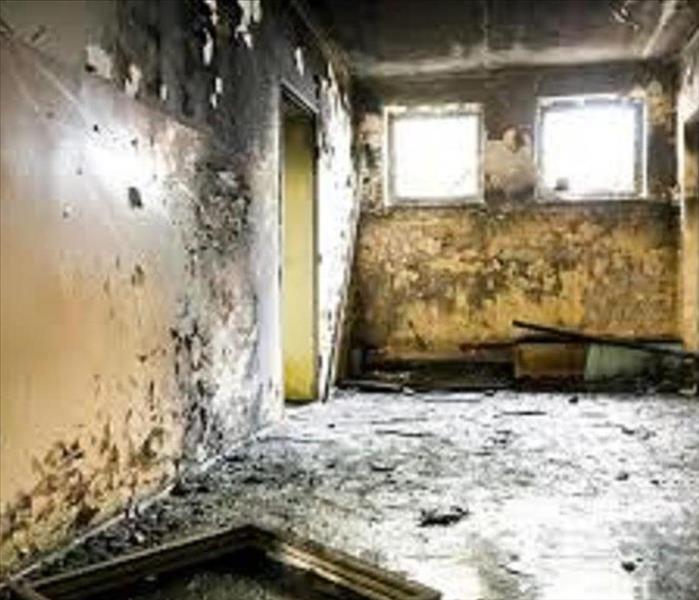 Mold Remediation in Haddonfield NJ, Mold Remediation in Cherry Hill NJ,
Mold Remediation in Haddonfield NJ, Mold Remediation in Cherry Hill NJ,
Mold Remediation in Haddonfield NJ, Mold Remediation in Cherry Hill NJ,
While residential property owners should be aware of conditions that could impact their home, learning about a mold infestation is particularly important. By getting a clear understanding of what mold is and how to prevent it, you can preclude your property from being subjected to structural damage and health hazards with mold remediation from SERVPRO. Learn more about mold and how to keep your property safe by reviewing this short outline:
Mold: A Brief Overview
Mold is a fungus. Positive factors for mold growth are moist, wet environments, a food source of cellulose or other organics and poor ventilation. Homeowners who suffer water damage often find that mold starts to proliferate in their residential property. If mold growth is not identified and treated, it can cause health effects. Additionally, mold can adversely impact your indoor air quality giving off a musty odor and cause discoloration of walls, ceilings and furniture.
Why You Should Hire A Professional Mold Remediation Specialist
Often, homeowners are interested in completing the mold removal process on their own. However, completing a do-it-yourself project in this instance is not very advisable. A small patch or a bit of mold on tile grout can be cleaned and controlled by a homeowner. Most homeowners do not possess the specialized equipment and safety gear and clothing required to execute the mold remediation services. Additionally, hiring a team of professional remediation specialists from SERVPRO can shorten significantly the unhealthy home air quality. Finally, most homeowners do not possess the knowledge and experience necessary to complete the mold removal process safely. When done incorrectly, DIY projects can cause you to spread the mold infestation in previously uncontaminated living areas thereby increasing susceptibility to health risks, structural damage, and costs.
Benefits Of Securing a Professional Mold Remediation Service
• Assessing the dangers of mold.
• Locating the source of the problem
•Containing affected regions of the home to prevent mold spore proliferation, including HVAC ductwork
• Eliminating the mold colonies, reducing mold spores to normal levels
•Cleaning, drying and disinfecting all surfaces affected by mold
Deodorizing the musty odor with ULV foggers
As an IICRC-certified company, the SERVPRO professionals are experts in Applied Microbial Remediation. Additionally, we are highly skilled in working directly with industrial hygienists, insurance adjusters, and residential property owners to offer full-service mold remediation service.
Having a company that can coordinate the whole process from start to finish to make your life easier, and gets you back in your home or business faster. “Like it never even happened.”
Stucco Remediation – What You Should Know
4/20/2017 (Permalink)
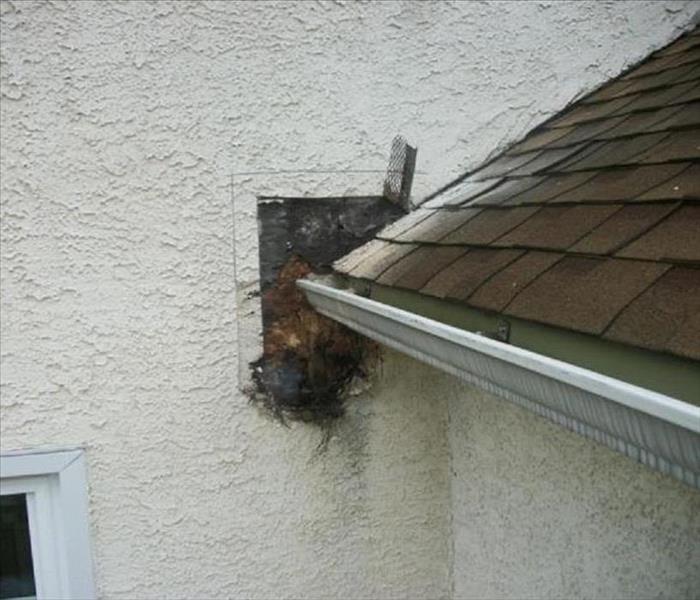 Stucco Remediation – What You Should Know
Stucco Remediation – What You Should Know
Stucco Remediation – What You Should Know
Every home, no matter when it was built or when you purchased it, can fall prey to stucco failure, mold and moisture contamination. Even the tiniest of cracks in the façade of your home can result in moisture coming in, which can then cause major problems. If that happens, it can threaten the very structure of your home as well as the health of your family. If it isn’t treated properly, mold can cause extensive and costly damage.
Signs that you need repairs include cracking or breaking in the façade of your home, or brown streaks below your windows or at intersection of the wall and roof. Inside, you’ll notice leaks in doors or windows, the bottoms of your windows may be discolored, your base trim can become warped and there may be wet carpet or a moldy smell in your home.
But did you know your stucco doesn’t even have to be cracked to have problems? Heller explains that it wasn’t until fairly recently that proper weep screens and break points in the stucco were required. That means walls may not breathe properly, which can allow moisture to build up and then be trapped.
That’s just one of the many reasons it is important to call your building contractor to inspect your home for damage. The contractor may be able to find problems that you never even knew existed and stop a problem before it becomes too big and costly.
The process of repairing the stucco is referred to as stucco remediation. Your first instinct may be to simply call a stucco company to repair the façade of your home, but that might not be the right thing to do.
Companies that are stucco only will have the know-how to remove and replace the existing façade of your home.
While this is important, it may simply cover up the effects caused by the moisture. The structural integrity of your home and the health of your family can still be in jeopardy if the underlying problems still exist.
Simply put, a stucco repair company could lack the knowledge and ability to identify and repair the problems that result from the water damage. And if they aren’t properly corrected, that can lead to even more damage and expense in the future.
Moisture intrusion most often affects stucco-clad homes, but can also affect homes made of brick, stone, wood or composite siding, and typically affects homes built between 1985 and 2003. Having the right person inspect your home for damage is crucial to find and repair problems to the home’s wood structure that aren’t visible to the eye. Rot and mold within the wall cavity can cause serious damage.
If you think your home may have fallen prey to moisture intrusion, then please give SERVPRO of Cherry Hill NJ a call...
Mold in Basement
1/20/2017 (Permalink)
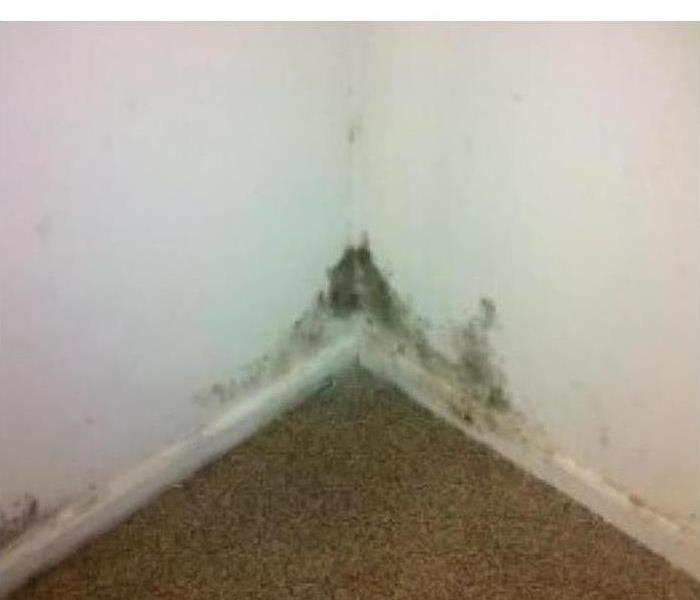 mold in corner
mold in corner
Mold and Your Health
Exposure to damp and moldy environments may cause a variety of health effects, or none at all. Areas that are likely to have mold, such as compost piles, cut grass, and wooded areas.
Molds are part of the natural environment. Outdoors, molds play a part in nature by breaking down dead organic matter such as fallen leaves and dead trees, but indoors, mold growth should be avoided. Molds reproduce by means of tiny spores; the spores are invisible to the naked eye and float through outdoor and indoor air. Mold may begin growing indoors when mold spores land on surfaces that are wet. There are many types of mold, and none of them will grow without water or moisture.
The key to mold control is moisture control. If mold is a problem in your home, you should clean up the mold promptly and fix the water problem.
It is important to dry water-damaged areas and items within 24-48 hours to prevent mold growth.
Molds gradually destroy the things they grow on. You can prevent damage to your home and furnishings, save money, and avoid potential health problems by controlling moisture and eliminating mold growth.






 24/7 Emergency Service
24/7 Emergency Service